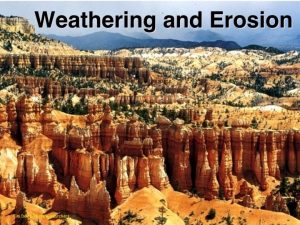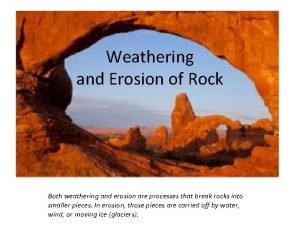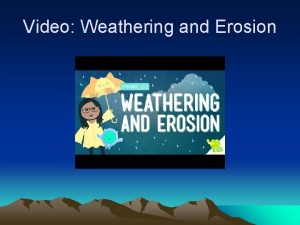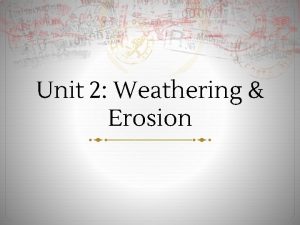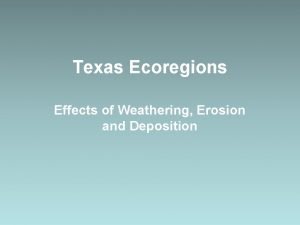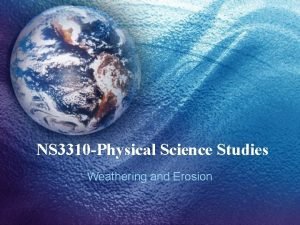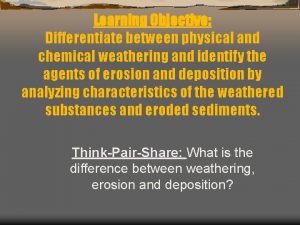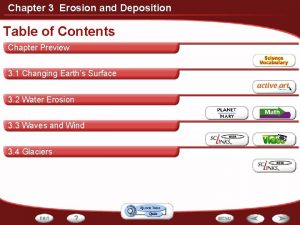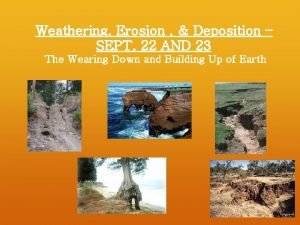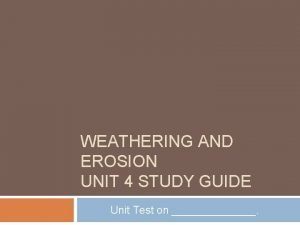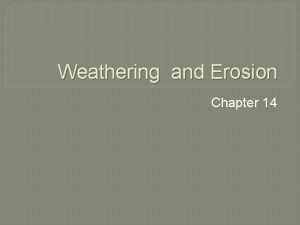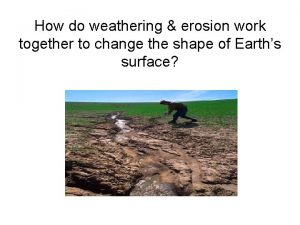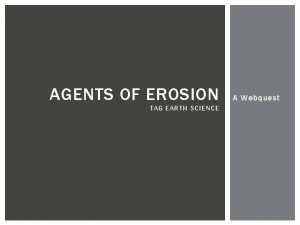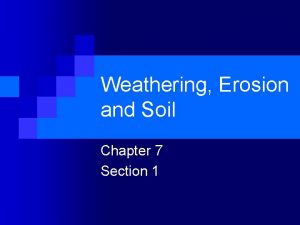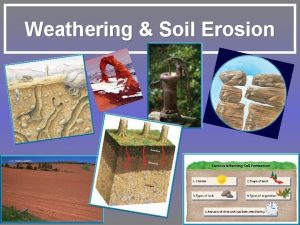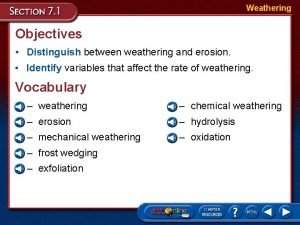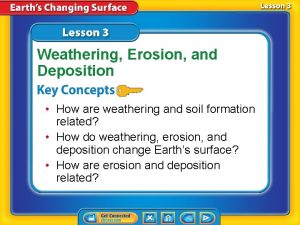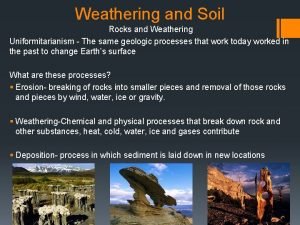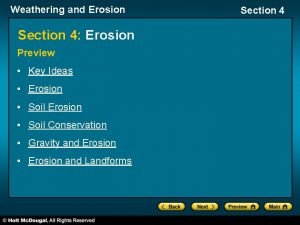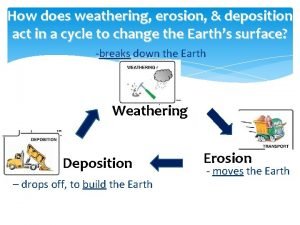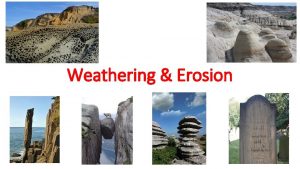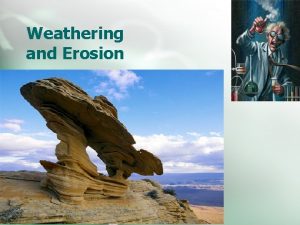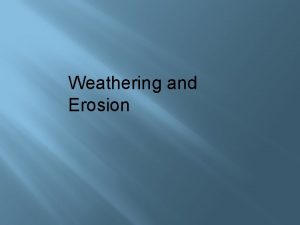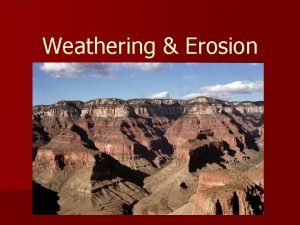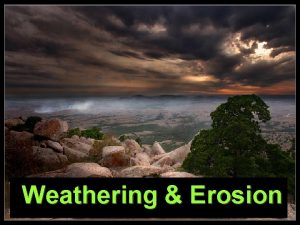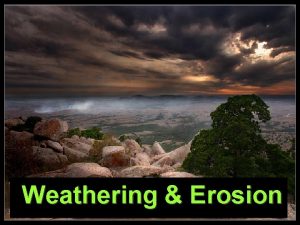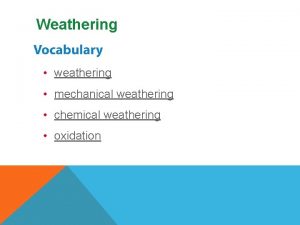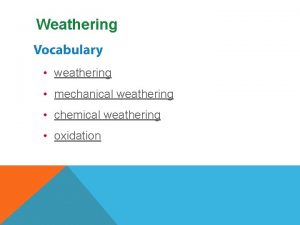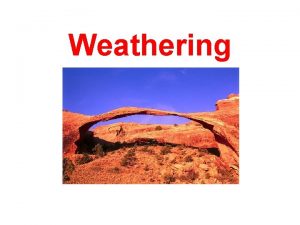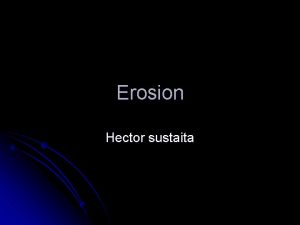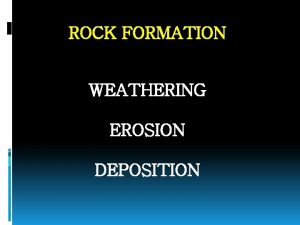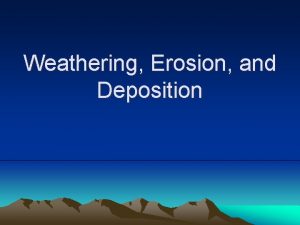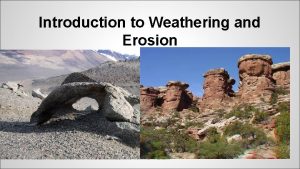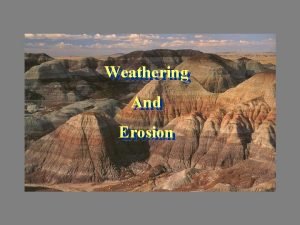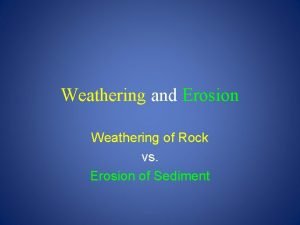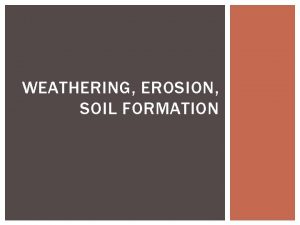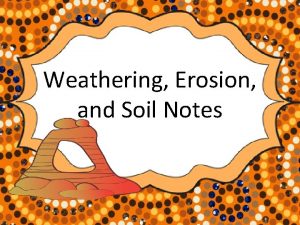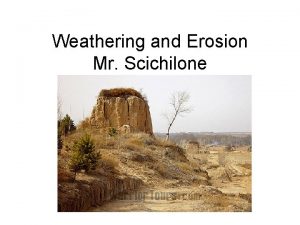Weathering and Erosion Weathering Section 1 Weathering and

























- Slides: 25

Weathering and Erosion Weathering Section 1

Weathering and Erosion Section 1 Objectives • Identify three agents of mechanical weathering. • Compare mechanical and chemical weathering processes. • Describe four chemical reactions that decompose rock.

Weathering and Erosion Section 1 Weathering Processes • weathering is the natural process by which atmospheric and environmental agents, such as wind, rain, and temperature, disintegrate and decompose rocks • There are two main types of weathering processesmechanical weathering and chemical weathering. • Each type of weathering has different effects on rock.

Weathering and Erosion Section 1 Weathering Processes • mechanical weathering is the process by which rocks break down into smaller pieces by physical means • Mechanical weathering is strictly a physical process and does not change the composition of the rock. • Common agents of mechanical weathering are ice, plants and animals, gravity, running water, and wind. • Physical changes within the rock itself affect mechanical weathering.

Weathering and Erosion Section 1 Mechanical Weathering Ice Wedging • A type of mechanical weathering that occurs in cold climates is called ice wedging. • Ice wedging occurs when water seeps into the cracks in rock and freezes. • When the water freezes, its volume increases by about 10% and creates pressure on the surrounding rock. • This process eventually splits the rock apart.

Weathering and Erosion Section 1 Here’s an example of ice wedging…

Weathering and Erosion Section 1 Mechanical Weathering, continued Abrasion • abrasion is the grinding and wearing away of rock surfaces through the mechanical action of other rock or sand particles • Rocks bump into each other and break • Abrasion is caused by gravity, running water, and wind. • Wind is another agent of abrasion.

Weathering and Erosion Section 1 Reading Check Describe two types of mechanical weathering. Two types of mechanical weathering are ice wedging and abrasion. Ice wedging is caused by water that seeps into cracks in rock and freezes. When water freezes, it expands and creates pressure on the rock, which widens and deepens cracks. Abrasion is the grinding away of rock surfaces by other rocks or sand particles. Abrasive agents may be carried by gravity, water, and wind.

Weathering and Erosion Section 1 Mechanical Weathering, continued Organic Activity • Plants and animals can also contribute to weathering. • As plants grow, the roots grow and expand to create pressure that wedge rock apart. • Earthworms and other animals that move soil expose new rock surfaces to both mechanical and chemical weathering.

Weathering and Erosion Section 1

Weathering and Erosion Section 1 Chemical Weathering • chemical weathering is the process by which rocks break down as a result of chemical reactions • Chemical reactions naturally occur between rocks, water, carbon dioxide, oxygen, and acids. • Bases can also chemically weather rock. • Chemical weathering changes both the composition and physical appearance of the rock.

Weathering and Erosion Section 1 Chemical Weathering, continued Oxidation • oxidation is a type of reaction that involves the transfer of electrons from one element to another • This usually occurs with oxygen (hence the name) • Rusting and corrosion are two common examples • Oxidation commonly occurs in rock that has ironbearing minerals, such as hematite and magnetite.

Weathering and Erosion Ouch! Section 1

Weathering and Erosion Section 1

Weathering and Erosion Section 1

Weathering and Erosion Section 1 Chemical Weathering, continued Oxidation, continued • Iron, Fe, in rocks and soil combines quickly with oxygen, O 2, that is dissolved in water to form rust, or iron oxide, Fe 2 O 3. 4 Fe + 3 O 2 2 Fe 2 O 3 • The red color of much of the soil in the southeastern United States is due to mainly the presence of iron oxide produced by oxidation.

Weathering and Erosion Section 1 Reading Check Describe two effects of chemical weathering. Two effects of chemical weathering are changes in the chemical composition and changes in the physical appearance of a rock.

Weathering and Erosion Section 1 Chemical Weathering, continued Hydrolysis • hydrolysis is a chemical reaction between water and another substance to form two or more new substances • Hydro = water, lysis = to split • Water plays a crucial role in chemical weathering. • Minerals that are affected by hydrolysis often dissolve in water. • Water can then carry the dissolved minerals to lower layers of rock in a process called leaching.

Weathering and Erosion Section 1 Chemical Weathering, continued The image below shows how water plays a crucial role in chemical weathering.

Weathering and Erosion Section 1 Chemical Weathering, continued Carbonation • carbonation the conversion of a compound into a carbonate • When carbon dioxide, CO 2, from the air dissolves in water, H 2 O, a weak acid called carbonic acid, H 2 CO 3, forms. H 2 O + CO 2 H 2 CO 3 • Carbonic acid has a higher concentration of hydronium ions than pure water does, which speeds up the process of hydrolysis.

Weathering and Erosion Section 1 Carbonation can result in cool structures

Weathering and Erosion Section 1 Chemical Weathering, continued Organic Acids • Acids are produced naturally by certain living organisms. • Lichens and mosses grow on rocks and produce weak acids that can weather the surface of the rock. • The acids seep into the rock and produce cracks that eventually cause the rock to break apart.

Weathering and Erosion Section 1 Chemical Weathering, continued Acid Precipitation • acid precipitation, such as rain, sleet, or snow, that contains a high concentration of acids, often because of the pollution of the atmosphere • Acid precipitation weathers rock faster than ordinary precipitation does. • Rainwater is slightly acidic because it combines with small amounts of carbon dioxide.

Weathering and Erosion Section 1 Chemical Weathering, continued Acid Precipitation, continued • But when fossil fuels, especially coal, are burned, nitrogen oxides and sulfur dioxides are released into the air. These compounds combine with water in the atmosphere to produce nitric acid, nitrous acid, or sulfuric acid. • The occurrence of acid precipitation has been greatly reduced since power plants have installed scrubbers that remove much of the sulfur dioxide before it can be released.

Weathering and Erosion Ice Wedging Section 1
 Soil erosion diagram
Soil erosion diagram How does weathering impact the edwards plateau ecoregion?
How does weathering impact the edwards plateau ecoregion? Difference between erosion and weathering
Difference between erosion and weathering Rain washing away soil from a hillside
Rain washing away soil from a hillside Bill nye weathering and erosion
Bill nye weathering and erosion Hydrolysis geology
Hydrolysis geology Weathering and erosion difference youtube video
Weathering and erosion difference youtube video Weathering and erosion essential questions
Weathering and erosion essential questions Piney woods erosion
Piney woods erosion Weathering erosion and deposition in texas ecoregions
Weathering erosion and deposition in texas ecoregions Agents of weathering
Agents of weathering Physical erosion
Physical erosion Weathering erosion and deposition
Weathering erosion and deposition Weathering and erosion
Weathering and erosion V shaped valley formed by
V shaped valley formed by Chapter 14 weathering and erosion review answers
Chapter 14 weathering and erosion review answers What happens when weathering and erosion work together?
What happens when weathering and erosion work together? Weathering webquest
Weathering webquest Chapter 7 weathering erosion and soil
Chapter 7 weathering erosion and soil Soils in ____ contain little organic material and are thin.
Soils in ____ contain little organic material and are thin. Distinguish between weathering and erosion
Distinguish between weathering and erosion Weathering and soil erosion
Weathering and soil erosion Weathering and soil erosion
Weathering and soil erosion Weathering and soil erosion
Weathering and soil erosion Grade 2 science worksheets
Grade 2 science worksheets Weathering and erosion
Weathering and erosion


